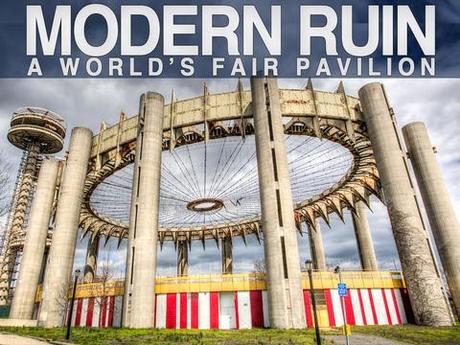
Matthew Silva's film Modern Ruin
Filmmaker and advocate Matthew Silva is working to get the 1964 New York Pavilion, designed by modernist icon Philip Johnson, restored.
It’s often said that in the borough of Queens, one of the most culturally diverse places on Earth, everyday is a world’s fair. The idiom rang true in 1964 during the World’s Fair in Flushing Meadows, an optimistic celebration perched at a moment between space age giddiness and late-’60s turbulence (as this pitch-perfect period footage demonstrates). Surrounded by structures representing other states, companies and newly liberated, post-colonial nations from Africa and Asia, the New York State Pavilion gave the Empire State a reason to stick out its chest and be proud. Designed by modernist icon Philip Johnson, the massive ring of steel and reinforced concrete piers, dubbed the “Tent of Tomorrow,” once held a cable suspension roof and was clad in a terrazzo floor featuring a Texaco highway map of the state. It was a platform for New York, and homegrown companies like Kodak and Corningware, to show off to the world, and as critic Louise Huxtable said, “a sophisticated frivolity…seriously and beautifully constructed … a ‘carnival’ with class.”
And now it sits, a rusted relic designed by one of the 20th century’s leading architects, partially in use and mostly forgotten. As the 50th anniversary of its construction looms, Long Island resident and teacher Matthew Silva wants to change that.
“It’s such a beautiful thing,” he says. “Tragic to learn that it’s in disarray.”
Silva’s journey from an architecture fan to an advocate for pavilion restoration is in many ways as long and circuitous as the structure itself. Growing up in Queens and Long Island, he’d often see it from the Long Island Expressway, and developed a curiosity about the concrete and steel behemoth. It wasn’t until he stumbled upon a book in a college library on Philip Johnson, which featured the World’s Fair building on the cover, that he decided to truly dive in. Someone had to have written a book about this thing, right?
Turns out, nobody had, so Silva began researching, gradually building a community around those with experience and knowledge of the Pavilion. He spoke to a couple in Cleveland that managed a roller rink that once was located on-site, the members of the New York State Pavilion Paint Project, working to restore the structure, and found out about the 1969 concert series, when bands such as The Grateful Dead, Led Zeppelin, Fleetwood Mac and Santana played under the Tent of Tomorrow. He even made the Pavilion part of his teaching curriculum—the middle school educator has his eighth graders design alternative uses for the pavilion in 2012. He did so much research that at one point, while he was getting a Masters at Stony Brook University on Long Island, he considered writing his thesis on the abandoned structure. Then one night, while he was driving by, looking at the unlit structure, it hit him—make a film.
Since that point, Silva has made great strides in both broadcasting the building’s story and building momentum and support for restoration. He just finished a successful Kickstarter to fund editing of his documentary, “Modern Ruin: A World’s Fair Pavilion,” for release this fall, and his organization, People for the Pavilion, which he co-founded with Salmaan Khan and Christian Doran, has garnered support from people such as New York Landmarks Conservancy Director of Development Scott Leurquin and Queens Borough President Melinda Katz, and helped expand the conversation about restoration.
“It’s such a unique, whimsical structure,” says Silva. “We hope a designer can redefine what a public pavilion can be.”
On April 22, the 50th anniversary of its construction, the structure will be open for the public to observe and take photos. While a small part of the structure is being used by Queens Theatre in the Park, the hope is wider exposure helps prod the city and state into restoring a bit of the luster this site once had.
